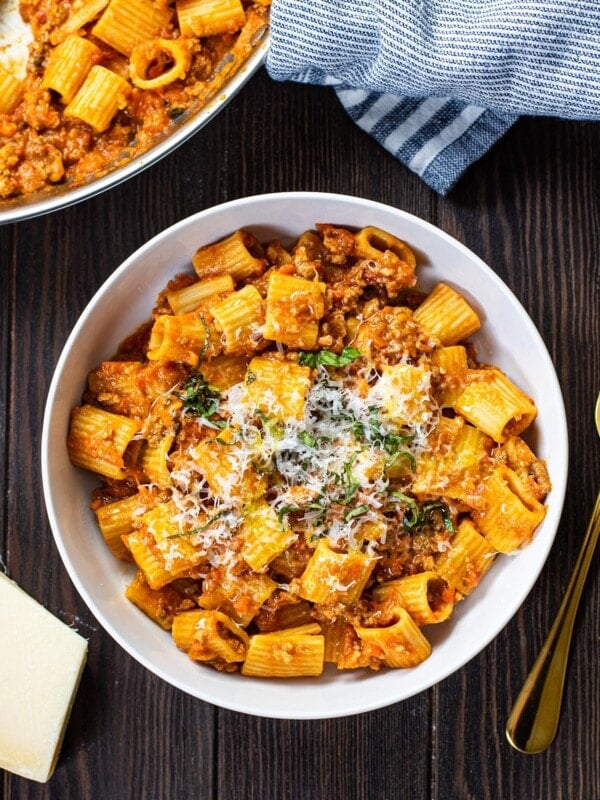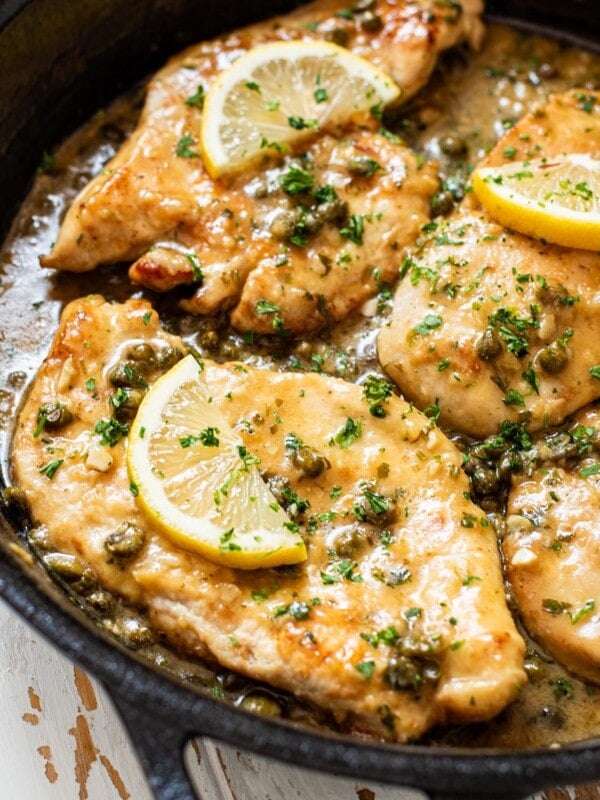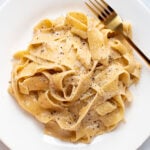This post may contain affiliate links. Please read our disclosure policy.
Cacio e pepe is a ridiculously simple and delicious Roman-born pasta dish made with pecorino romano cheese and ground black pepper. This creamy, cheesy, peppery, and slightly spicy dish is reminiscent of pasta carbonara. It comes together in 25 minutes and we almost always have the ingredients on hand.
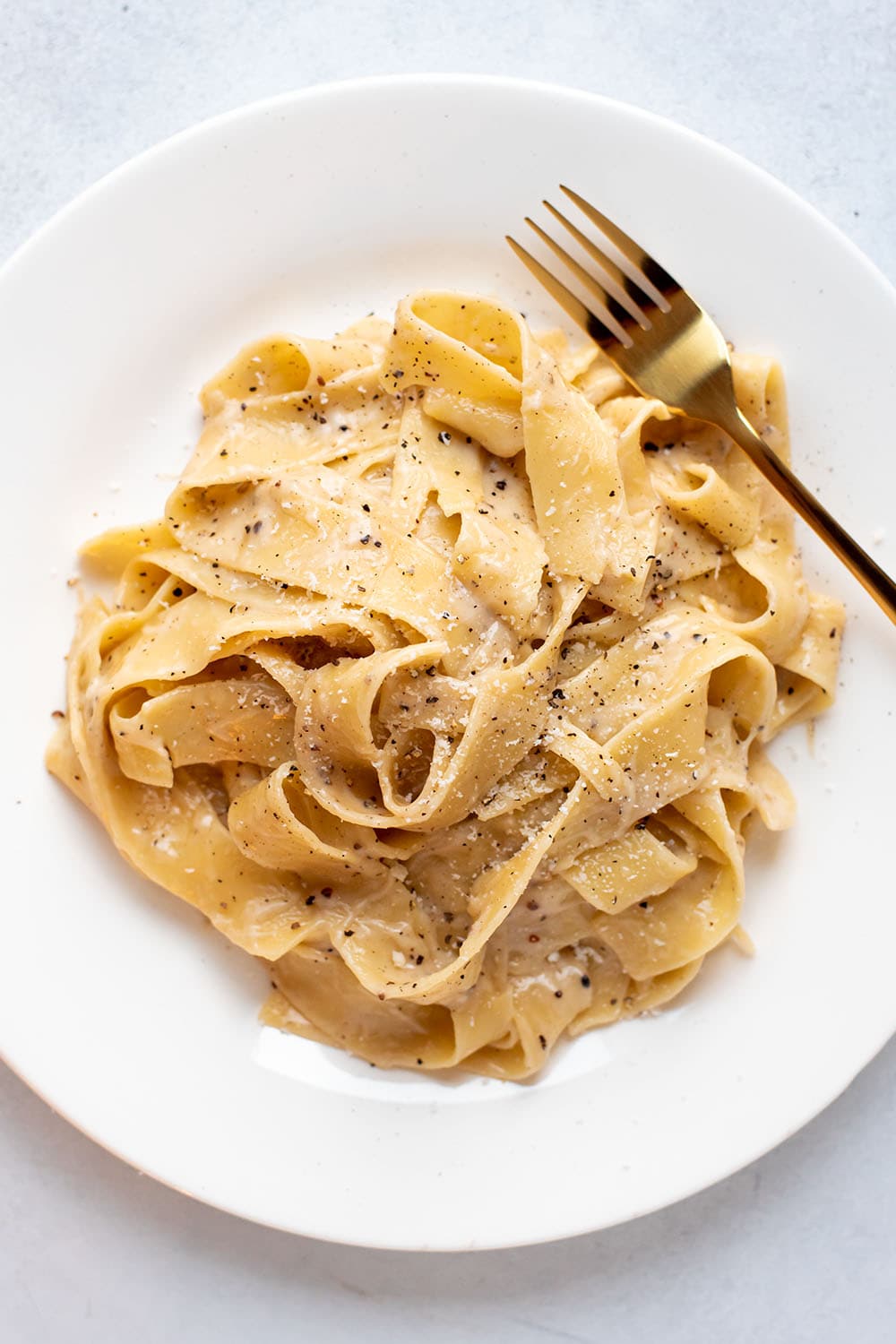
Table of Contents
Why This Recipe Works
Our cacio e pepe (translated as ‘cheese and pepper’ and pronounced kaa·chee·oh ee peh·pay) is made with pappardelle pasta, freshly grated pecorino romano cheese, and freshly ground black peppercorns.
The secret lies in releasing the peppercorn’s robust flavor by simmering in pasta water, releasing delicate aroma and spices. Combined with parmesan cheese, pasta, and starchy pasta water, the dish transforms into a rich and creamy sauce made with just two ingredients.
Many variations of this recipe call for butter and olive oil, however, this is the most traditional way to cook the dish.
I’m all about sticking to the classics, which is why I prefer to make my pesto from scratch, too. Make a classic red sauce with only three ingredients, and we can’t forget a basic (but delicious) Margherita pizza.
Ingredients

- Pappardelle, linguini, bucatini, or spaghetti: It’s best to use noodle-based pasta over anything tubular. These are best for soaking up the creamy sauce.
- Pecorino romano cheese: always use a block of pecorino romano cheese (nothing pre-grated). This ensures fresher flavor and better melting. Pre-shredded packaged cheese tends to clump more because of the preservatives. Parmigiano reggiano can be substituted. The finer the cheese, the easier it will melt! Use the extra on my parmesan risotto or baked truffle fries recipe.
- Freshly cracked black peppercorns: At a minimum, set your pepper grinder to the largest gap possible. The fresher the peppercorns the better. Anything precracked will lack freshness.
- Reserved pasta water: pasta water helps to release the flavor from the peppercorns and adds richness to the cheesy sauce.
- Chopped bacon: bacon is not traditional but I love adding it for flavor and extra protein. Look for thick-cut bacon or even pancetta.
See the recipe card for full information on ingredients and quantities below.
How to Make Cacio e Pepe
Step 1.
Bring a large pot of generously salted water to a boil. You will be cooking pasta until it’s a little firmer than al dente. Just to note, you’re going to want to save the pasta water for later steps so do not discard it at any point. Read the tips in my post for the best results!
Step 2.
Meanwhile, heat ground black pepper in a large nonstick pan or Dutch oven on high heat for 1 minute. Once the pasta has been cooking for about 6 minutes, add 1/2 cup of pasta water to the pan. Simmer until the liquid is slightly reduced, about 3-4 minutes. The aroma should be intense!
Step 3.
Once pasta is just under al dente, use tongs to transfer it directly to the pan with the pepper sauce. Toss to evenly coat in the pepper water. Reduce heat to medium, add 1/2 cup of pasta water, and continue to cook, tossing occasionally, until pasta is al dente.
Step 4.
Turn off the heat. If you have an electric range, remove the pan from the burner. Sprinkle half the cheese over the pasta and toss until melted. Repeat with the remaining cheese and toss until creamy and fully incorporated. You can add extra pasta water as needed if the sauce feels too thick.

Step 5.
Serve immediately topped with extra cracked pepper and grated cheese. The dish tends to lose its creamy texture if it sits out for too long.
Expert Tips
- Use a large nonstick pan or Dutch oven. A nonstick surface makes the process a little easier but use the largest pan you have so you can adequately toss the pasta in the cheese sauce.
- Always use freshly ground whole peppercorns. Most people at this point have a pepper mill/pepper grinder in their kitchen. Opt for this over pre-ground black pepper or anything like that. Traditionally, whole peppercorns are pre-toasted (whole) before being ground and added to the pan. This is not always feasible so it’s fine to toast them after they have been ground. Always opt for a very coarse grind.
- Remove the pan from the burner when you add the cheese. Overheating the cheese causes clumping that can’t be reversed.
- Boil pasta just under al dente. The pasta will continue to cook in the pan and the extra texture is going to make this dish that much more memorable. I love using pappardelle and bucatini since it’s larger. Regular or thick spaghetti would probably be the most authentic.
Frequently Asked Questions
If the sauce is too thick, add more pasta water to help thin it. If too thin, add more cheese.
The dish is not difficult to make, you just need to ensure you use the right amount of pasta water and not too much heat. Overheating pecorino or parmesan cheese will make it clumpy. Finer grated cheese will melt effortlessly.
Cream and butter are nontraditional ingredients in cacio e pepe. The secret lies in the starchy pasta water, which boosts the overall richness of the sauce as it congeals.
More Italian Favorites
Enjoy this recipe? If you made this recipe, please leave a ★ ★ ★ ★ ★ star rating in the recipe card below & a review in the comments!
Bucatini Cacio e Pepe Recipe
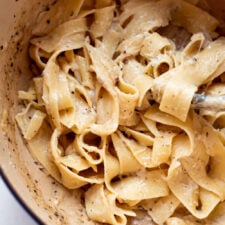
Ingredients
- 12 ounces pappardelle, fettuccine, bucatini, or spaghetti
- 2 cups (0.5 lbs) grated pecorino romano cheese (do not buy pre-ground), very finely grated
- 2 teaspoons freshly cracked black peppercorns, coarsely cracked
- Reserved pasta water, about 1 1/2 cups
- Salt for pasta water
- See note below on optional chopped bacon**
Instructions
- Bring a large pot of generously salted water to a boil. You will be cooking pasta until it’s a little firmer than al dente. Just to note, you’re going to want to save the pasta water for later steps so do not discard it at any point. Read the tips in my post for best results!
- Meanwhile, heat ground black pepper in a large nonstick pan or dutch oven on high heat for 1 minute. Once the pasta has been cooking for about 6 minutes, add 1/2 cup of pasta water to the pan. Simmer until the liquid is slightly reduced, about 3-4 minutes. The aroma should be intense!
- Once pasta is just under al dente, use tongs to transfer it directly to the pan with the pepper sauce. Toss to evenly coat in the pepper water. Reduce heat to medium, add 1/2 cup of pasta water, and continue to cook, tossing occasionally, until pasta is al dente.
- Turn off the heat. If you have an electric range, remove the pan from the burner. Sprinkle half the cheese over the pasta and toss until melted. Repeat with the remaining cheese and toss until creamy and fully incorporated. You can add extra pasta water as needed if the sauce feels too thick.
- Serve immediately topped with extra cracked pepper and grated cheese. The dish tends to lose its creamy texture if it sits out for too long.
Notes
Nutrition
Nutrition information is automatically calculated, so should only be used as an approximation.

